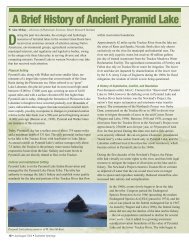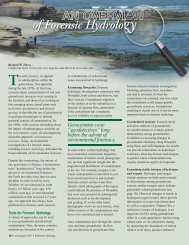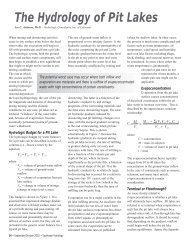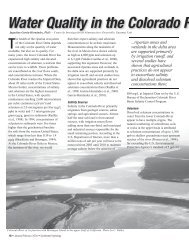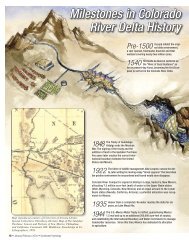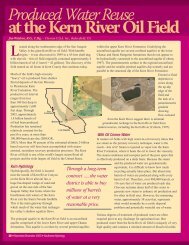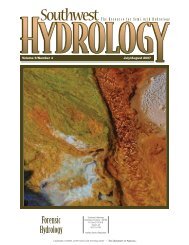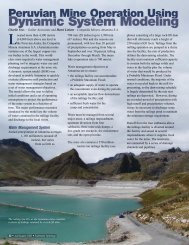Constructed Wetlands - Southwest Hydrology
Constructed Wetlands - Southwest Hydrology
Constructed Wetlands - Southwest Hydrology
Create successful ePaper yourself
Turn your PDF publications into a flip-book with our unique Google optimized e-Paper software.
<strong>Constructed</strong> <strong>Wetlands</strong><br />
for Natural Wastewater Treatment<br />
Robert A. Gearheart, Ph.D. – Humboldt State University<br />
<strong>Constructed</strong> wetlands represent a relatively new<br />
ecological engineering approach to treating wastewater<br />
using natural systems. The concept developed from<br />
observations that natural wetlands remove contaminants from<br />
watersheds, inspiring an ecological engineering movement to<br />
design systems to meet certain discharge requirements. The first<br />
wetland was constructed in East Germany 40 years ago, where<br />
“reed bed” systems were used to treat domestic effluent.<br />
The way natural wetlands, often considered the kidneys of<br />
the watershed, reduce organic and inorganic contaminants is<br />
similar to the processes at work in constructed wetlands: they<br />
accumulate suspended solids, oxidize organic and inorganic<br />
compounds, decompose detrital plant material, and remove<br />
and discharge nutrients from aquatic plant communities. Both<br />
natural and constructed wetlands provide habitat for fish,<br />
aquatic invertebrates, aquatic fowl, and other species.<br />
Sweetwater <strong>Wetlands</strong>, a free-surface wetland in Tucson, Arizona.<br />
do the work of removing and converting contaminants. Freesurface<br />
wetlands usually are lined with geotextile materials<br />
or clays. They may require several growing seasons to attain<br />
conditions that provide reliable and effective treatment.<br />
Vegetated gravel beds are treatment wetlands with a gravel<br />
substrate and aquatic plants, or basically hydroponic systems where<br />
plant roots move into the interstices of the gravel. These systems<br />
have less ecological value than free-surface wetlands and perform<br />
about as well as anaerobic bioreactors. They can be hydraulically<br />
loaded horizontally or vertically (see page 29 for discussion of<br />
vertical flow wetlands); upward vertical feeds are called upflow<br />
systems. Although also called subsurface wetlands (see page<br />
26), vegetated gravel beds are not technically wetlands because<br />
they lack the wide variety of aquatic organisms of true wetlands,<br />
and gravels are seldom a substrate of choice in natural settings.<br />
The biological processes that occur in wastewater treatment systems<br />
are also like those in constructed wetlands, and include settling,<br />
microbial oxidation, anaerobic decomposition, nutrient uptake,<br />
nitrification, denitification, adsorption, desorption, and precipitation.<br />
But constructed wetland systems use aquatic plants such as cattails<br />
and bulrushes and their associated bacterial populations to break<br />
down contaminants into relatively innocuous byproducts. Thus,<br />
wetlands can effectively treat domestic wastewater, industrial<br />
wastewater, animal wastewater, contaminated groundwater,<br />
mine waste, urban runoff, and other contaminated waters.<br />
<br />
<br />
<br />
<br />
<br />
<br />
Profile of a typical free-water surface wetland.<br />
<br />
<br />
<br />
<br />
<br />
Types of <strong>Constructed</strong> <strong>Wetlands</strong><br />
Free-surface wetlands are usually 1.5 to 4 feet deep with dense<br />
populations of floating, submergent (entirely below-surface),<br />
and emergent (rooted in water but partly exposed) aquatic<br />
plants interspersed with open-water surfaces. They support<br />
complex aerobic and anaerobic microbial communities. Those<br />
communities in the rhizosphere (the area around the roots)<br />
<br />
<br />
<br />
<br />
<br />
Profile of a vegetated gravel or subsurface flow wetland.<br />
<br />
16 • January/February 2006 • <strong>Southwest</strong> <strong>Hydrology</strong>
Photo: Elizabeth Willott<br />
Passive System Benefits<br />
The major advantage of constructed wetlands over more<br />
conventional treatment systems is their passive operation. For<br />
example, in wetlands that receive stormwater, inorganic solids<br />
settle, organic solids settle and decompose, oils and petroleum<br />
products adsorb to detrital plant material, organisms such as fecal<br />
coliform are removed, and metals adsorb and precipitate. All<br />
these processes occur without active control or introduction of<br />
energy or chemicals, offering considerable economic benefits as<br />
well as ensuring long-term reliability of the treatment system.<br />
Periodic maintenance, however, is usually needed. In free-surface<br />
constructed wetlands, accumulated settled solids and detrital<br />
materials must be removed. The prescribed maintenance is to<br />
remove 15 to 20 percent of the material every five to seven years,<br />
while leaving most of the active rhizosphere in the wetland. In<br />
vegetated gravel beds, the gravels become clogged with roots and<br />
solids and the gravel and plants eventually must be replaced.<br />
<strong>Wetlands</strong> systems have proved effective in a wide range of climatic<br />
conditions. They operate successfully in Canada and the northern<br />
United States, as well as in tropical areas. They work particularly<br />
well in hot, arid climates where high temperatures, long days, and<br />
aridity create conditions conducive to a thriving ecosystem with<br />
accelerated micriobial processes from the introduced wastewater.<br />
<strong>Constructed</strong> wetlands offer more than just an economical, reliable<br />
water treatment system; they assist at the watershed scale in<br />
supporting natural systems and compensate for the loss of natural<br />
wetlands. They provide habitat for wildlife, open space, and<br />
opportunities for environmental education,<br />
research, and passive recreation. More than 60<br />
municipal constructed wetlands in the United<br />
States take advantage of these benefits.<br />
Space is a Consideration<br />
Adequate space is obviously an important<br />
factor in evaluating the suitability of a<br />
constructed wetland. The area needed is<br />
usually a function of the amount of flow expected. The design<br />
flow for a domestic wastewater treatment system usually assumes<br />
a 20-year growth prediction. For urban runoff, agricultural runoff,<br />
and silvicultural activities, design flow is a function of the runoff,<br />
infiltration, and other hydrologic characteristics of the contributing<br />
area. Land targeted for the wetland also should be relatively flat,<br />
not an existing natural wetland, and available for a reasonable price.<br />
These criteria reduce the use of constructed wetlands to communities<br />
and industries with low to medium flows and available space.<br />
For example, a wetland that treats domestic effluent to secondary<br />
standards requires about 15 to 20 acres per million gallons of flow.<br />
Applications<br />
Urban runoff: The most common use of constructed wetlands<br />
is to treat stormwater and urban runoff. They effectively remove<br />
sediments and their associated contaminants (such as heavy<br />
The major advantage<br />
of constructed wetlands<br />
over more conventional<br />
treatment systems is<br />
their passive operation.<br />
metals), organisms such as fecal coliform, and hydrocarbons. These<br />
systems can be included in landscaped development projects or<br />
retrofitted into urban stream and watershed restoration projects.<br />
Their passive nature makes them effective in combination with more<br />
active best management practices for controlling urban runoff.<br />
Mine waste: Vegetated gravel beds have been very effective in<br />
treating mine drainage (see page 20). Underground mining activities<br />
and seeps often expose rocks and tailings to oxygen and acidic<br />
water, resulting in runoff with high concentrations of toxic metals<br />
such as zinc and cadmium. Their passive nature and adaptability to<br />
a wide range of climate and geographic locations make constructed<br />
wetlands especially suitable for remote mining operations.<br />
Nitrates and perchlorate: <strong>Constructed</strong> wetlands can treat<br />
groundwater high in nitrates from industrial and agricultural<br />
activities by converting the nitrates to nitrogen gas. At the<br />
Apache Nitrogen Products Inc. (ANPI) constructed wetlands<br />
in Arizona (see page 22), groundwater nitrate concentrations<br />
of up to 300 milligrams per liter (mg/L) were reduced to<br />
under 10 mg/L (the federal drinking water standard), with<br />
less than a five-day retention. Although external carbon must<br />
be added at ANPI, sufficient carbon normally accumulates<br />
from plant decay in the wetlands to support denitrification.<br />
<strong>Constructed</strong> wetlands also show potential for perchlorate<br />
removal. Researchers have isolated an organism that reduces<br />
perchlorate to chloride which is similar to those that convert<br />
nitrates to nitrogen gas. The organism came from a domestic<br />
wastewater wetland in Arcata, California, and likely may be found<br />
wherever nitrates are being denitrified.<br />
Hybrids<br />
Hybrid systems incorporating constructed<br />
wetlands with conventional treatment<br />
systems work well in small community<br />
wastewater treatment operations.<br />
Pretreatment, as by septic tanks, may be<br />
needed to reduce organic and suspended<br />
solids from animal waste, domestic waste, or stormwater that<br />
can overload, plug, or fill wetlands. Post-wetland water disposal<br />
may also be required if the wetland has insufficient infiltration<br />
capacity. Hybrid systems also may use vegetated gravel beds,<br />
eliminating open water and thereby reducing mosquito habitat.<br />
The Future<br />
The future looks bright for constructed wetland technologies to<br />
help address a wide variety of current and emerging pollution<br />
problems, such as endocrine disrupters and pesticides. The<br />
interest and involvement of experts from a range of disciplines,<br />
including hydrology, plant ecology, microbiology, landscape<br />
architecture, soil science, conservation biology, vector<br />
control, and environmental engineering will be required to<br />
plan, design, and manage this promising technology.<br />
Contact Robert Gearheart at rag2@humboldt.edu.<br />
January/February 2006 • <strong>Southwest</strong> <strong>Hydrology</strong> • 17



